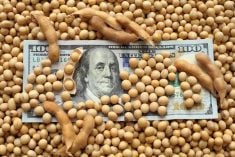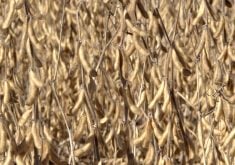MarketsFarm — Like many other crops across Western Canada, chickpeas weren’t immune to hot and dry growing conditions over the summer.
This year’s domestic chickpea crop is only expected to weigh in at 63,000 tonnes, according to Statistics Canada — less than one-third of the five-year average of 189,600 tonnes.
In Saskatchewan, some parts of the province saw worse conditions than others.
“Anything east of Moose Jaw (has a) significantly better yield than anywhere west,” said Colin Young, manager of Mid-West Grain at Moose Jaw.
Read Also

U.S. grains: Soybeans touch 16-month high, wheat firm on Chinese demand hopes
Chicago soybean futures hit 16-month highs on Monday on expectations China will restart large-scale U.S. soy buying after the two countries reached a deal to de-escalate their trade war.
“If you look to the west of Moose Jaw, we have a terrible crop. (There are) yields in the single digits to the low-teens. The long-term kabuli chickpea average yield is 28 bushels to the acre. They would be well below average and I would argue half of average. Towards the east, yields are approaching average.”
A rash of localized hail storms last month may have also reduced the Saskatchewan chickpea crop, but its harvest continued afterward. Young estimated 25 per cent of the crop has come off the ground, while the province said 11 per cent as of Aug. 30 in its latest crop report released last Thursday (Sept. 2).
“I’m not anticipating it to be a horribly low-quality crop by any means. But I think with the strength of the export market, the discounts are going to be more minimal for the slightly damaged crops than other times of the year,” Young said.
Canada’s chickpea crop is not the only one to see a sharp reduction, as both the U.S. and Turkey are also facing low production numbers. As a result, Canadian chickpeas will remain competitive in the global market, according to Young.
“The world is short of chickpeas. The market has responded; the price has gone up from (double) where it was a calendar year ago,” he said.
“The Americans won’t face price pressures. The Turkish are going to move from a position of chickpea exporter to importer. Our main competitor with stocks to sell is Russia. They had a decent crop with about the same amount of acres as last year.”
Kabuli chickpeas in Western Canada are seeing high-delivered bids between 40 and 60 cents/lb., an increase of at least 14 cents from last month, according to Prairie Ag Hotwire data from Friday.
With tightening supply, Young can’t predict how high chickpea prices will go, but he said they will reach the peak soon enough and encourages growers to participate in the market.
“We’re already at levels that are trending towards the historical high price. Does the market have the ability to shatter the ceiling like canola or wheat? It has the potential, yes. But it’s anybody’s guess,” he said.
“There’s nothing wrong with the current price…It really helps take the sting out of the really disastrous yield.”
— Adam Peleshaty reports for MarketsFarm from Stonewall, Man.













